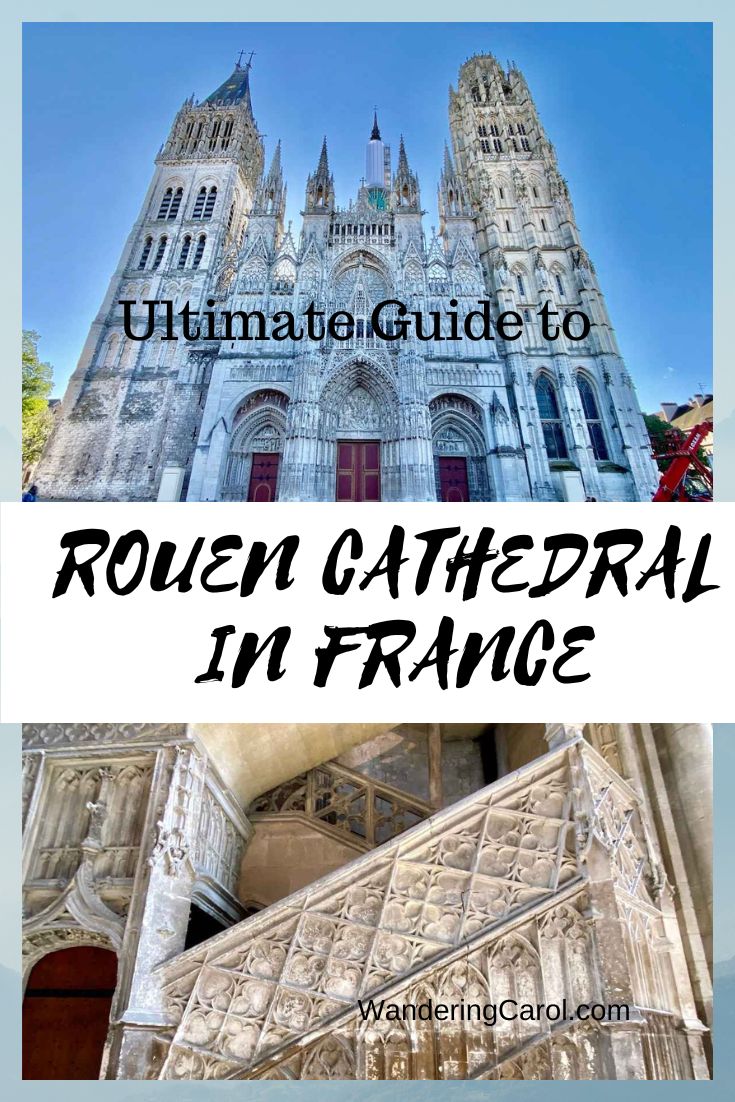This post may contain affiliate links.
Join me on a journey through Rouen Cathedral in Normandy. You’ll never view it the same way again.
The Gothic Splendor of Rouen Cathedral
Picture an intricate lace design transformed into solid white limestone.
This was my initial impression of Rouen Cathedral, one of Normandy’s most remarkable landmarks, located just under two hours away from Paris by train.
If you’re planning a visit, this guide is here to assist you.
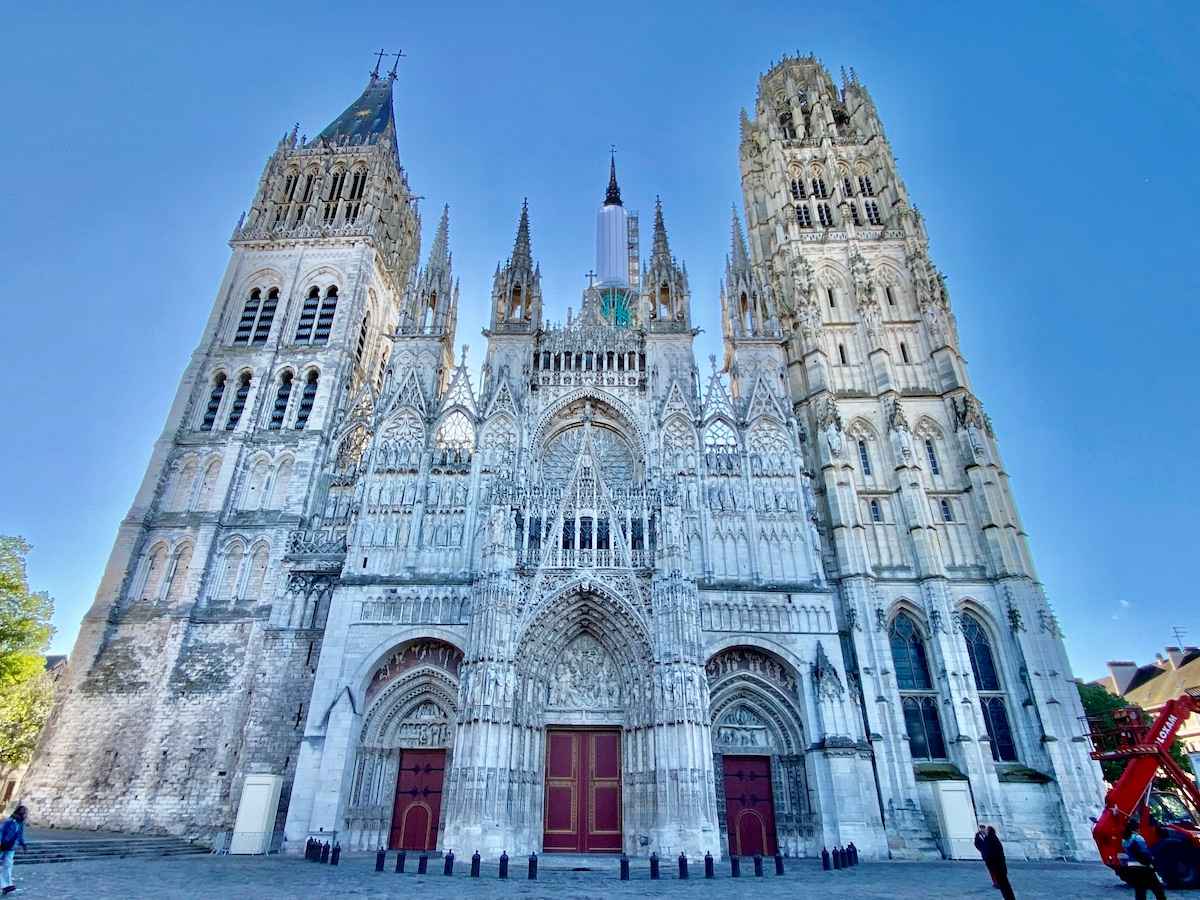
A View That Changes Constantly
As I stood in awe of its stunning portals, distinct towers, and intricate carvings, a thought crossed my mind.
Was I here to see the cathedral itself, or was I experiencing it at a specific moment in time, illuminated by a particular light?
Because every glance offered a different perspective.
Monet and Rouen Cathedral
Indeed, Claude Monet captured it in various lights, painting it no less than 28 times (30 if you count the Saint-Romain Tower).
He set up his easel facing the western facade and intensely focused on his Rouen Cathedral Series both on-site and in his studio from 1892 to 1893.
Rather than depicting the cathedral’s hard reality, he was captivated by the play of light and shadow dancing across its ornate exterior walls.
“To truly paint the cathedral, one must capture its essence, its spirit that changes with the light and the hour.”
Claude Monet
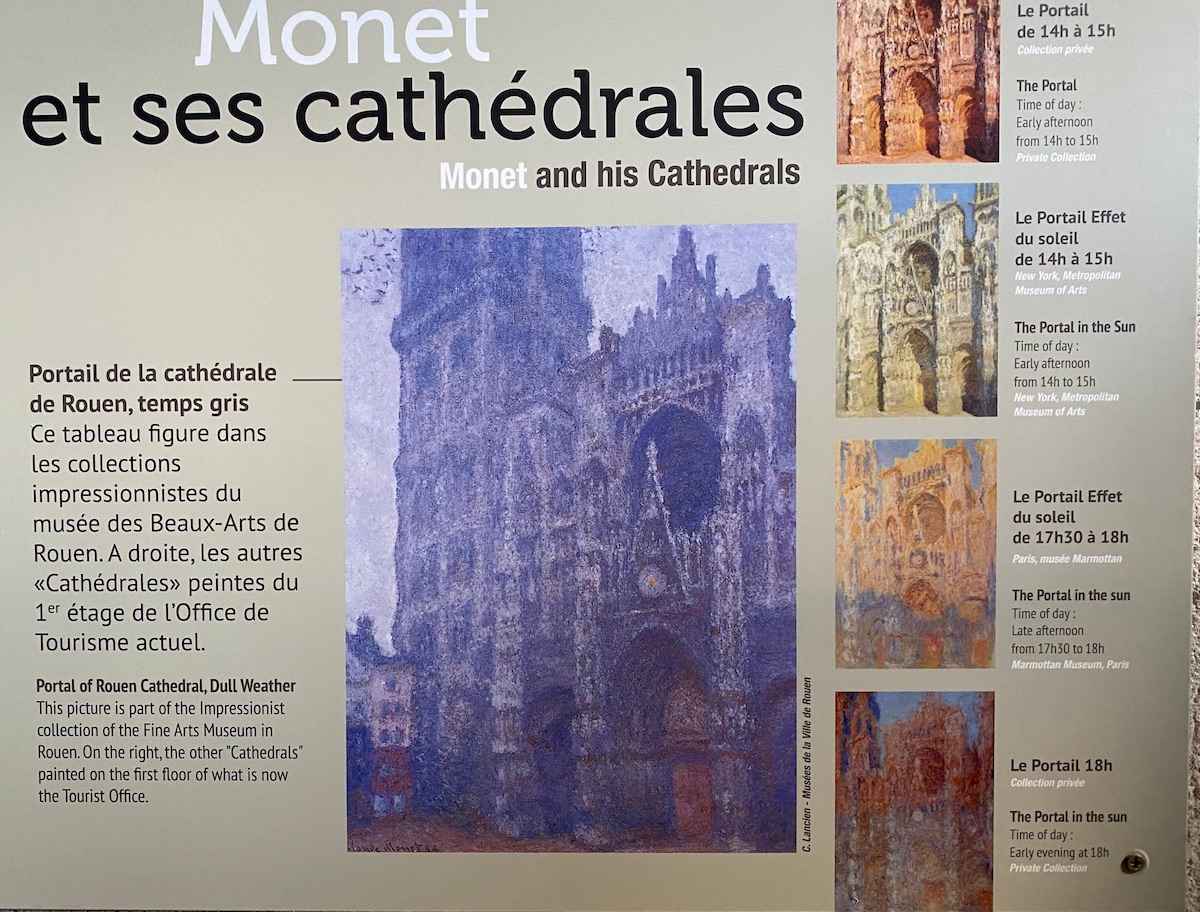

Monet’s Favorite Spot at the Place de la Cathédrale
Fortunately, I was able to view the cathedral from one of Monet’s favored locations – a former lingerie shop window across the square.
Much of the series was created from this vantage point, leading to one of the most impactful images in Impressionist art to emerge from France.
Indeed, I enjoyed a unique opportunity.
Impressionism in Normandy
Normandy is celebrated as the birthplace of Impressionism. I was there on a press trip with a few journalists to honor the 150th anniversary of Impressionist art, which allowed me access to Monet’s perspective.
Currently, the unembellished area at the Renaissance-era Finance Building located at 25 Place de la Cathédrale remains closed to the public, though plans to open it are in progress.
One can only hope they recreate its original atmosphere with period lingerie.
It’s a charming notion. Just imagine women shopping for corsets and garments while a man passionately paints in the adjoining room!
Schedule a private guided tour of Giverny and Rouen from Paris, complete with a Michelin-star lunch.
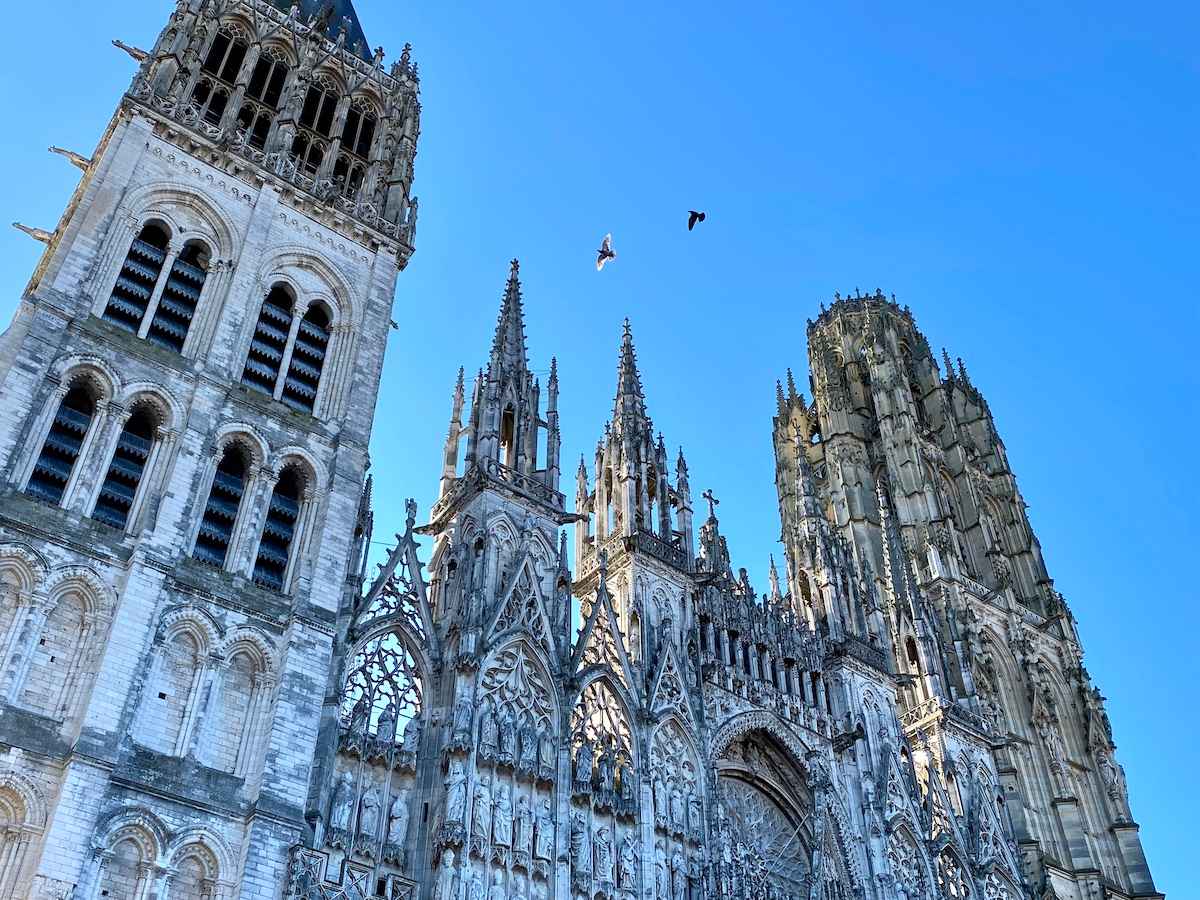

Why Does Rouen Cathedral Attract So Many Visitors?
Monet’s dedication to painting the cathedral undoubtedly elevated its status, but the Cathédrale Notre–Dame de Rouen was magnificent even before that.
As an 800-year-old masterpiece, it stands as one of France’s finest examples of Gothic architecture.
Its site has a rich history as a place of worship, dating back possibly to 260 CE when Christianity took hold in Rouen.
A History Filled with Turmoil
We know that a basilica was constructed here around 395 and later expanded. However, the Vikings wreaked havoc in the 9th century.
A Romanesque cathedral was built in the 11th century, though only the crypt survives today. The remainder was rebuilt in exquisite Gothic style during the 12th century.
Visiting Rouen Cathedral – Key Moments in History
Restorations and additions have continued over the centuries, making the cathedral a living testament to evolving architecture. Here are a few significant milestones in its history:
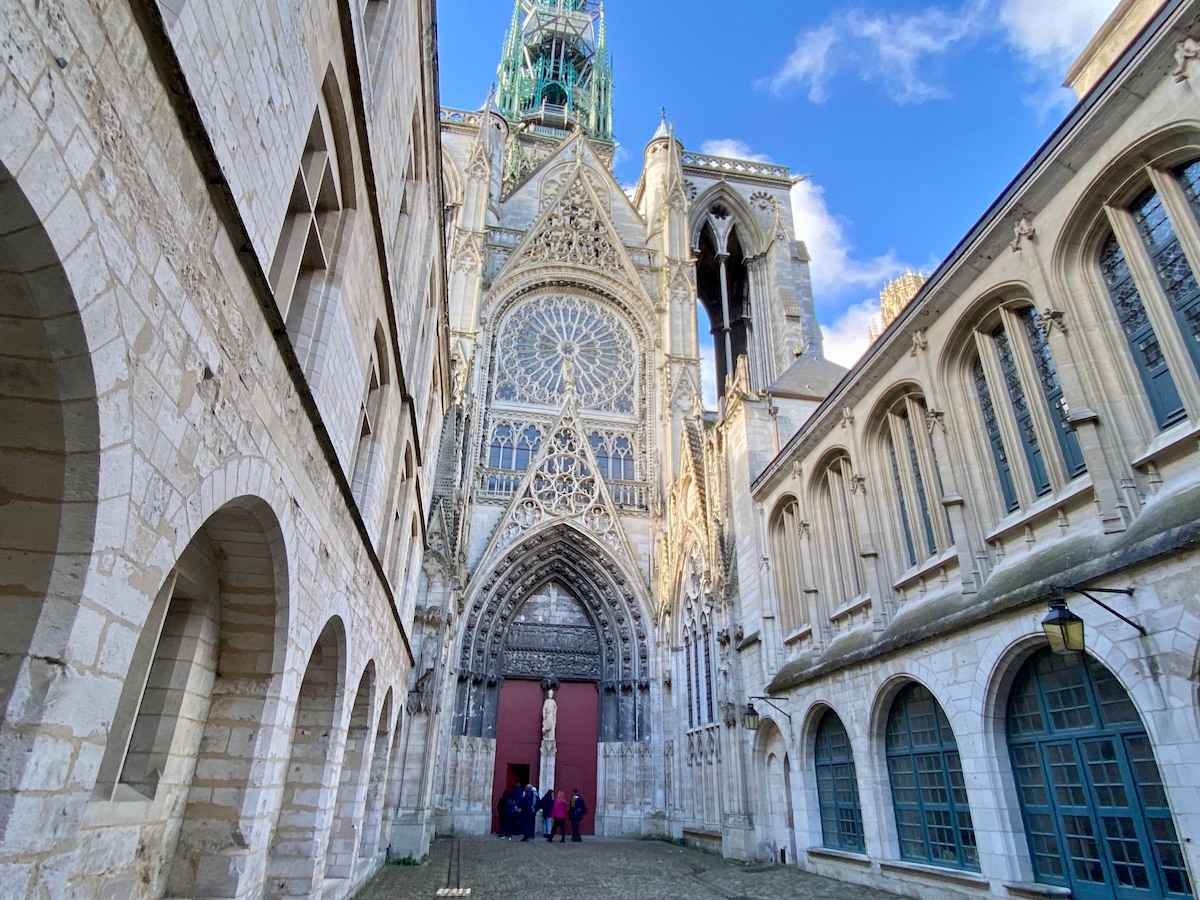

The West Facade and Portals (14th and 15th centuries):
- The west facade that so enchanted Monet was redesigned with 70 carved figures and intricate stonework from 1362 to 1421.
The Butter Tower (Tour de Beurre) (1488-1506):
- Isn’t that an amusing name? This tower was funded through the sale of indulgences, allowing the wealthy to consume butter during Lent. It embodies Flamboyant Gothic architecture and highlights people’s love for butter!
The Iron Spire (1822-1876):
- After the wooden spire was struck by lightning, it was replaced with a taller iron structure.
- Reaching 151 meters into the sky, it made the cathedral the tallest building in the world at the time.
- The iron spire stirred controversy, with writer Gustave Flaubert calling it “the dream of a metalworker in delirium.”
World War II Damage and Restoration (1944-1956):
- Unfortunately, the cathedral was severely damaged during Allied bombings in World War II, leading to many years of restoration efforts.
Fire on the Spire (July 2024):
- Following the devastating fire at Notre-Dame Cathedral in Paris in 2019, there was a tense moment when plastic sheeting covering Rouen’s cathedral spire caught fire during restoration. Thankfully, 70 firefighters intervened, and the cathedral was mostly saved. (This incident proved Flaubert right about the advantages of having an iron spire instead of a wooden one.)
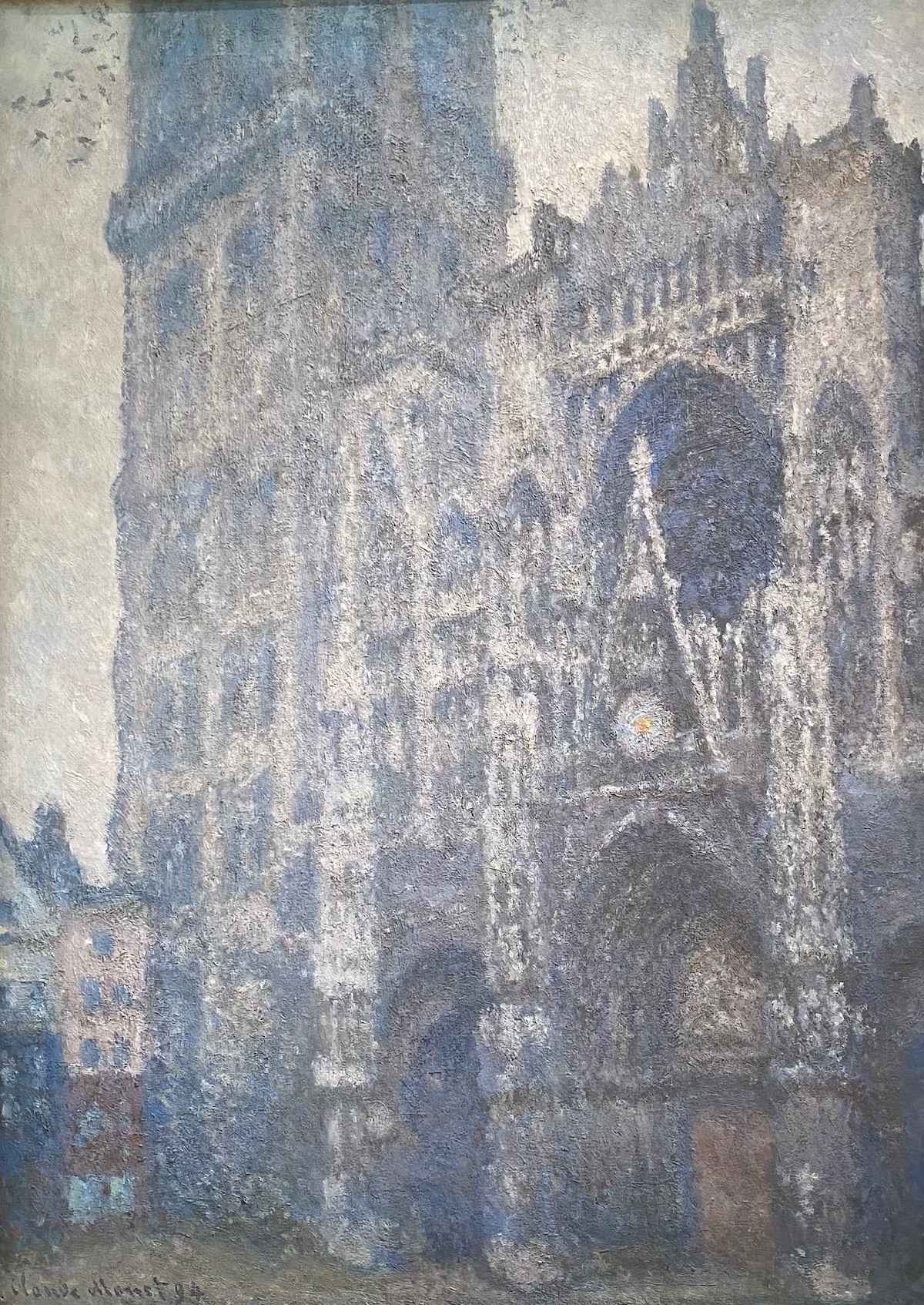

Monet’s Fascination
The cathedral’s western facade, with its intricate details and shadowy crevices, captivated and perplexed Monet.
His passion for his work sometimes led to deep frustration.
“I spent the night haunted by nightmares. The cathedral seemed ready to fall on me; its colors shifted from blue to pink to yellow.”
Claude Monet
He would simultaneously work on several canvases, alternating between them based on the weather and the sun’s position in the sky.
The resulting paintings are thickly layered, capturing everything from the softest dawn hues to rich golds and deep shadows, focusing as much on the atmosphere as on the structure itself.
Interestingly, Monet did not step inside the cathedral until after completing the series.
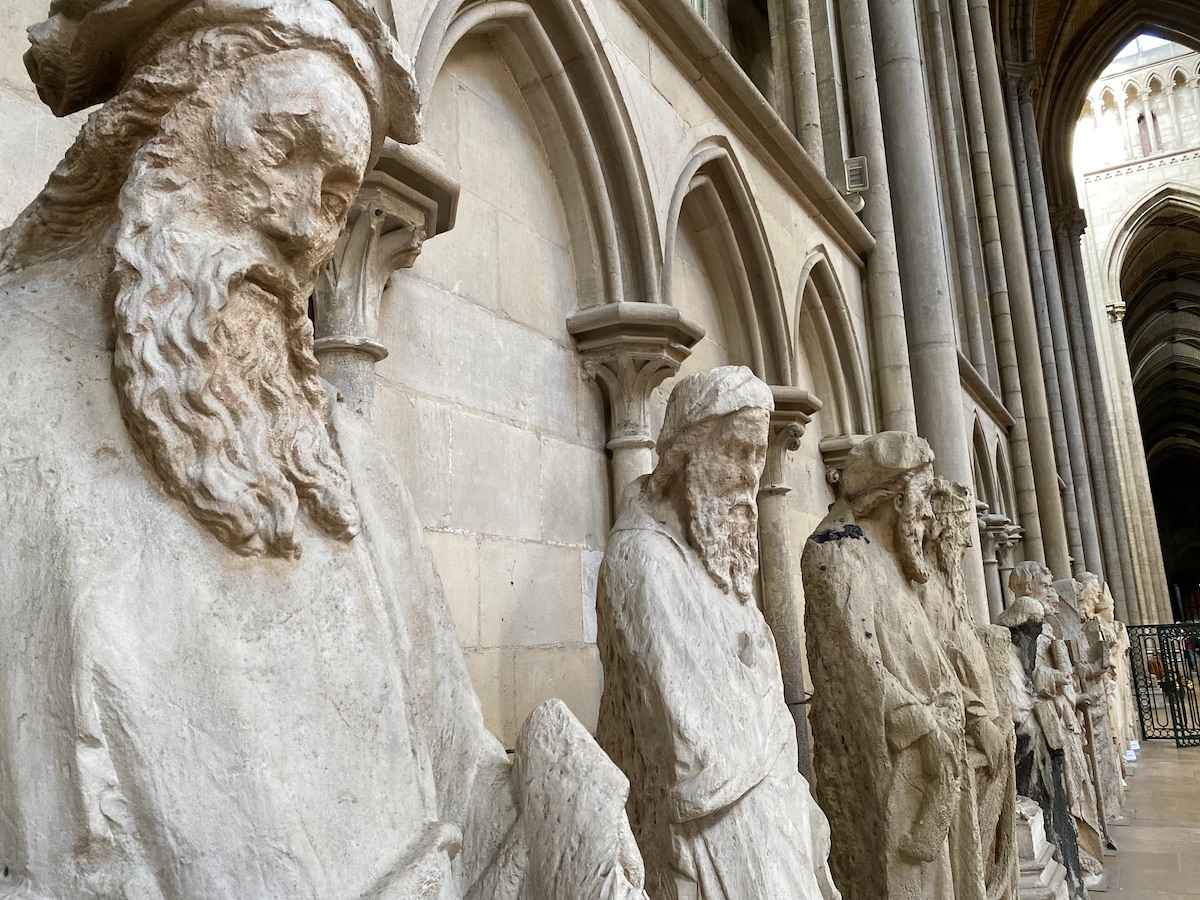

Exploring Rouen Cathedral
I had never visited the interior before, and it was about time I did.
On my first trip to Rouen, I only had time to quickly admire the cathedral as the sun cast a fiery glow upon its top before hastily making my way to Étretat.
Now, as I entered the centuries-old interior, an air of tranquility enveloped me.
Sunlight filtered through the ancient stained glass, pointed arches soared upwards, and a faint scent of frankincense and aged wood filled the air.
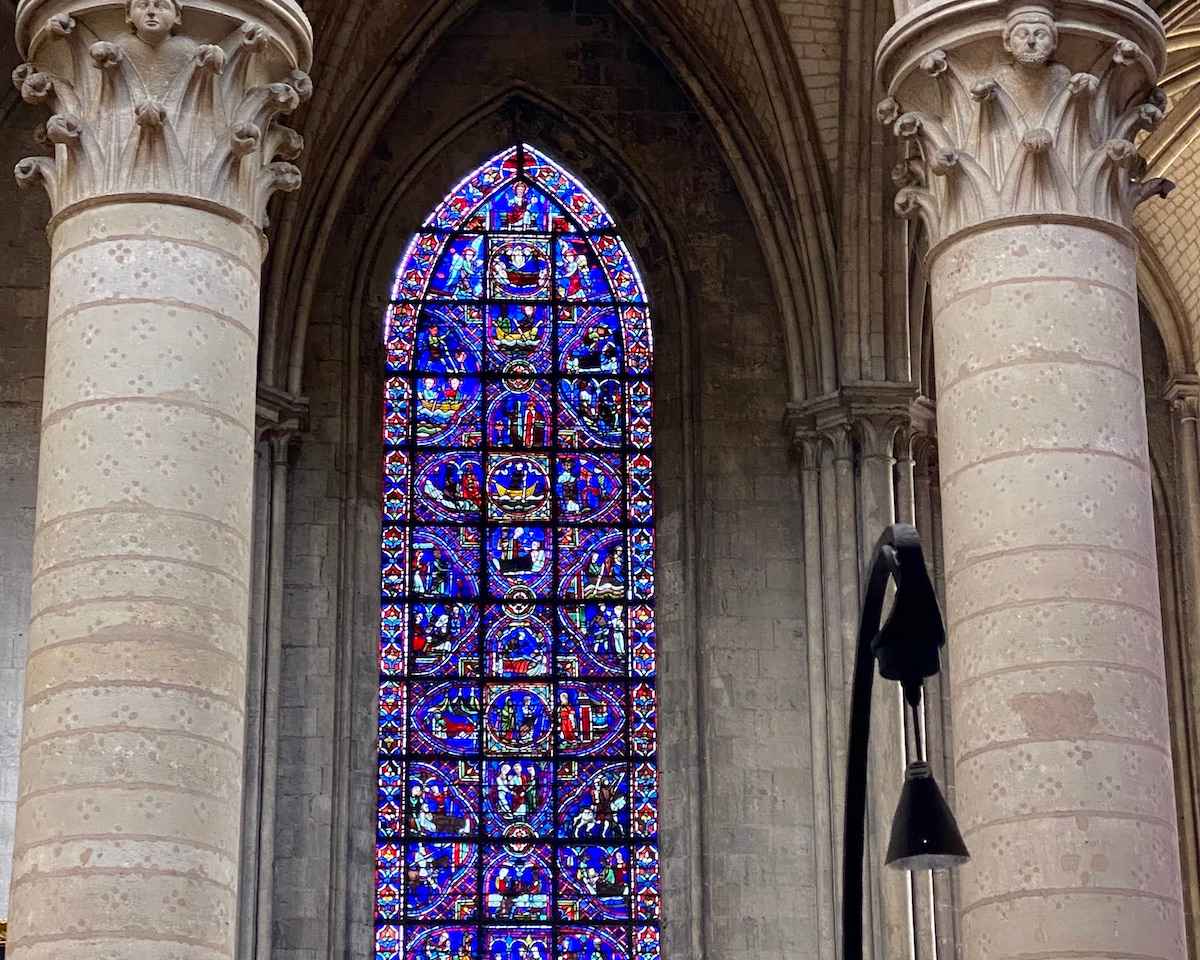

What to Explore Inside the Cathedral
While the overall interior might appear sparse (some visitors may not appreciate it), the rich history of Normandy is embedded throughout, and several key features await discovery.
The Tomb of Rollo
Rollo (or Rollon), the Viking Chieftain, who converted to Christianity and became the first Duke of Normandy, was interred in Rouen Cathedral in 930.
This burial occurred long before the present Gothic cathedral exists, as well as before its earlier Romanesque predecessor.
His tomb has been relocated several times, damaged, and subjected to bombing, so it’s no surprise that the current version is not original.
The Tomb of Richard the Lionheart
Richard the Lionheart, although King of England, was also Duke of Normandy, and Rouen Cathedral contains his heart – literally, while most of his remains were laid to rest in Fontevrault.
Chapel of the Virgin
One of the cathedral’s highlights is the Lady Chapel, also known as the Chapel of the Virgin, which requires a guided tour for entry.
This chapel, dedicated to the Virgin Mary, is the largest within the cathedral and showcases priceless medieval and renaissance stained glass that overlooks the Renaissance tombs of the Amboise cardinals.
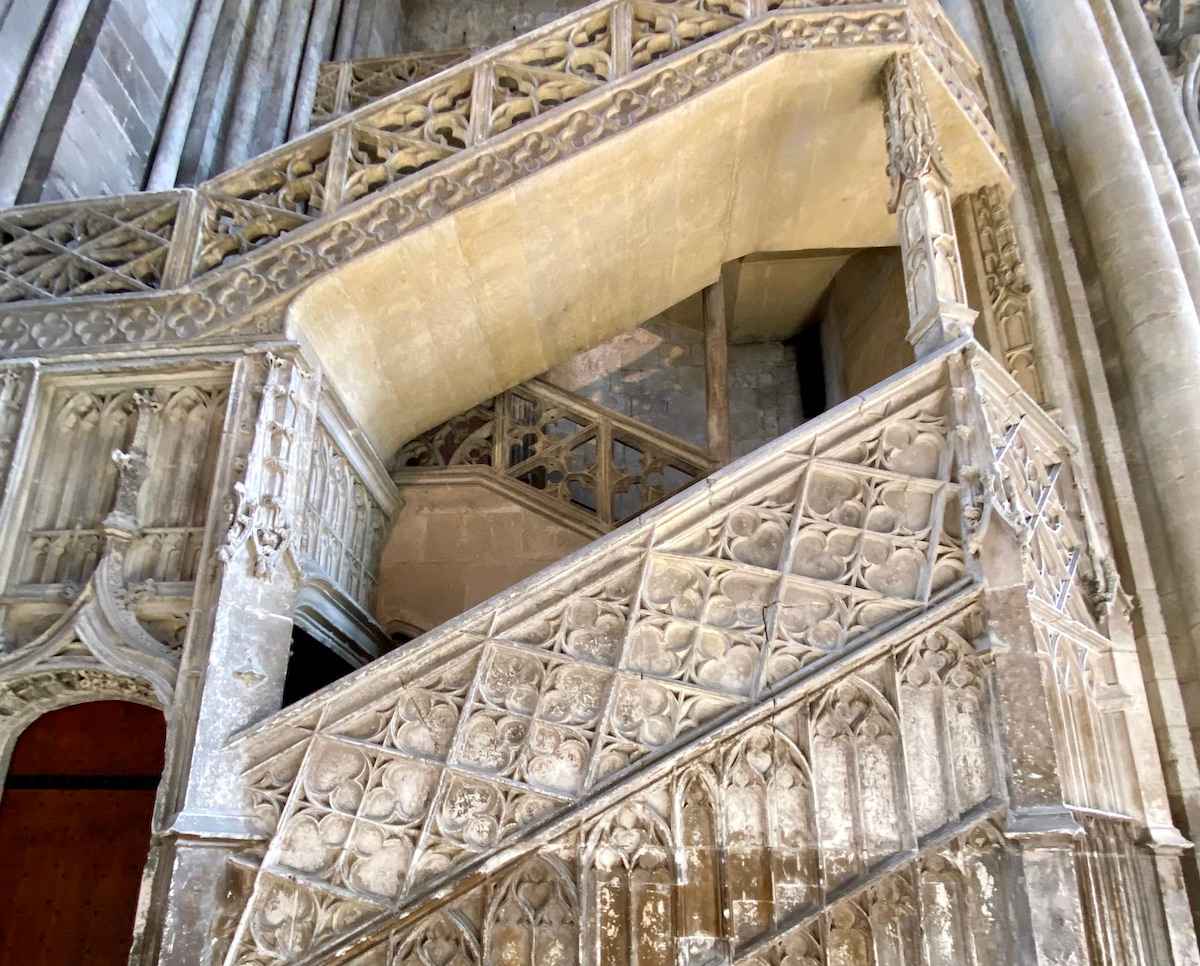

The Booksellers’ Staircase
The Booksellers’ Staircase, known as the Escalier de la Librairie, once led to the chapter library.
Exquisitely carved with delicate stonework, it reflects the artistry of late medieval and early Renaissance craftsmen.
Travel Tip: It got its name due to the booksellers who utilized the library upstairs, trading their books around the cathedral.
Joan of Arc Chapel
A chapel dedicated to Joan of Arc, who was tried and executed in Rouen, can be found within the cathedral.


Intricate Carvings
A row of carved figures moved from the west facade offers a uniquely human touch to the cathedral.
As I walked past these weathered sculptures, I couldn’t help but picture a bearded Monet.
Why hadn’t he explored the cathedral before completing his Rouen Cathedral Series?
How could someone so driven to paint a spiritual landmark like this – a strong symbol of permanence and solace – resist uncovering its secrets and intricacies?
Did he fear that visiting might alter his perception of it?
Why Did Monet Choose to Paint Rouen Cathedral?
The most straightforward answer is that Monet aimed to capture the fleeting beauty of light rather than the cathedral’s steadfastness. He focused on how transient light illuminated the architecture, symbolizing life’s impermanence.
For Monet, the spiritual essence was perhaps not in the strength of the structure, but in the evanescent moments – the brief intervals when the light transforms everything.
“Everything changes,” he remarked, “even stone.”
5 Essential Tips for Visiting Rouen Cathedral
1. Don’t Miss the Light Show
- During summer evenings, Rouen Cathedral presents a stunning light spectacle named “Cathedral of Light”, illuminating the facade with a captivating display.
2. Opt for a Guided Tour
- A guided tour available at 2:30 PM during weekends offers deeper insights into the cathedral’s history, architecture, and significance.
- These tours include access to areas that are generally not open to the public, such as the crypt and the Chapel of the Virgin.
3. Check Service Times and Opening Hours
- If you’re not attending a service, it’s advisable to avoid visiting during mass, as it can restrict your exploration and disturb others. Remember that the cathedral is, above all, a sacred space and should be treated with respect.
- Note that on Mondays, the cathedral doesn’t open to the public until 2:00 PM.
4. Discover the Historic Old Town
- The area surrounding Rouen Cathedral is rich in history and charm, featuring narrow cobblestone streets, quaint half-timbered houses, and an impressive 14th-century astronomical clock.
5. View Original Impressionist Works
- Don’t overlook a visit to the Rouen Museum of Fine Arts (Musée des Beaux-Arts), where one of Monet’s masterpieces, entitled Rouen Cathedral, Facade and Tour d’Albane. Grey Weather, is displayed.
- While there, explore the museum’s outstanding collection of Impressionist art.
- The Musée d’Orsay, the leading Impressionist museum in Paris, displays five paintings from the Rouen Cathedral Series.
